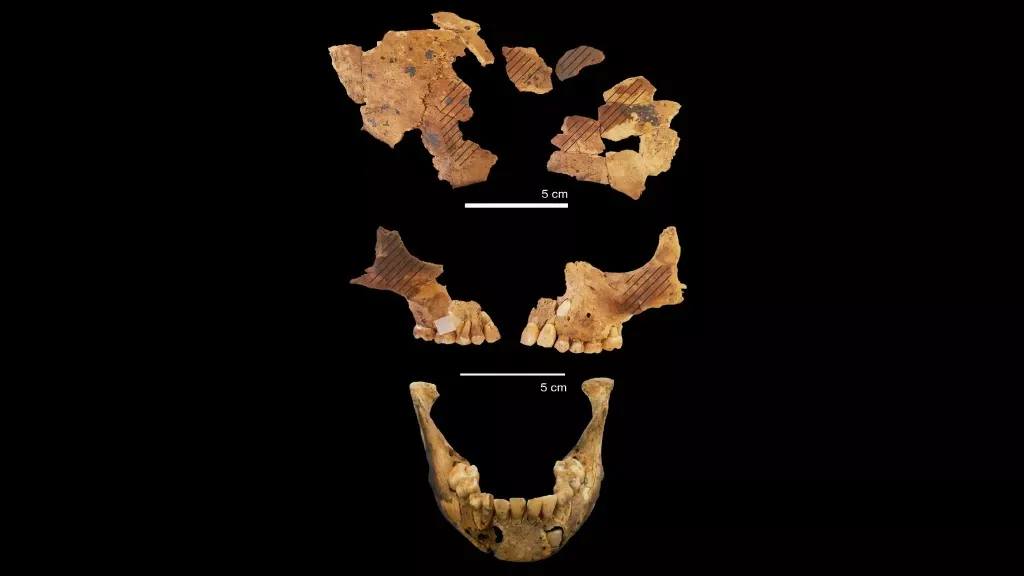8,000 Years Ago, a Child in Indonesia Was Buried Without Their Arms and Legs
Ancient humans often modified the bones of their dead as part of funerary rituals
/https://tf-cmsv2-smithsonianmag-media.s3.amazonaws.com/filer/e1/5a/e15a86d1-3cc7-48c8-9b21-8fea62ce2189/makpan_cave_alor_island.jpg)
Archaeologists in Indonesia have discovered the 8,000-year-old remains of a child buried with the long bones of their arms and legs removed, likely as part of a ceremonial practice, reports Laura Geggel for Live Science.
The youngster’s cheeks and forehead were painted with red ocher, a pigment used in burials in many ancient societies; an ocher-colored cobblestone was also placed beneath their head.
Per Athena Chan of the International Business Times, archaeologists have found child burials in the region before—the newly detailed site is inside Makpan cave on Alor, a 900-square-mile island that lies between the Flores and Savu seas—but they were far more recent than the new find, which dates to the early–mid-Holocene epoch. The team’s analysis is published in the journal Quaternary International.
“Child burials are very rare and this complete burial is the only one from this time period,” says lead author Sofia Samper Carro, an archaeologist at Australian National University, in a statement. “From 3,000 years ago to modern times, we start seeing more child burials and these are very well studied. But, with nothing from the early Holocene period, we just don’t know how people of this era treated their dead children. This find will change that.”
Based on the youngster’s teeth, the researchers estimate that they were between 6 to 8 years old at time of death. But the skeleton is unusually small for a child of that age, instead appearing to belong to a 4- to 5-year-old.
Samper Carro says the team plans to investigate whether this diminutive stature was a product of diet or environmental issues, or perhaps a genetic characteristic particular to people living on an isolated island.
“My earlier work from Alor showed adult skulls were also small,” she adds. “These hunter-gatherers had a mainly marine diet and there is evidence to suggest protein saturation from a single food source can cause symptoms of mal-nourishment, which affects growth. However, they could have been eating other terrestrial resources such as tubers.”

Per the study, the removal of the long bones is not a unique finding—but this is the first time researchers in the region have observed the phenomenon in a child’s burial. Archaeologists previously recorded similar bone removals in adults buried on the nearby islands of Java, Borneo and Flores around the same time period.
“We don’t know why long bone removal was practiced, but it’s likely some aspect of the belief system of the people who lived at this time,” says Samper Carro.
As the authors write in the paper, the findings suggest that the people who conducted the burial either postponed initial interment or exhumed “and then reburied [the child] without the long bones,” which were buried separately from the rest of the remains (and have not been found).
To date, researchers have discovered a trove of evidence suggesting that people in many ancient societies modified the bones of their dead as part of burial rituals. At one early Holocene site in the Philippines, a 2013 study led by Myra Lara, an archaeologist at the University of the Philippines–Diliman, found that ancient humans had separated and de-fleshed bones in a complicated procedure. And, as Colin Barras reported for New Scientist in 2016, a group based in central South America shifted burial practices around 9,600 years ago, adopting complex rituals including bone removal and delayed interment.
In some prehistoric communities, funerary practices differed based on whether the deceased was an adult or a child. According to the study, “This has been considered to demonstrate differing levels of social embodiment and personhood, which come with growth and increased biological age.”
Last November, researchers in Salango, Ecuador, revealed a similarly eerie child burial: namely, the skeletons of two infants wearing what appeared to be bone “helmets” made from the skulls of older children.
As lead author Sara Juengst of the University of North Carolina–Charlotte told Newsweek’s Artistos Georgiou at the time, members of the Guangala culture likely outfitted the babies with skulls “in reaction to some sort of natural or social disaster and [to ensure] that these infants had extra protection or extra links to ancestors through their burials.”
/https://tf-cmsv2-smithsonianmag-media.s3.amazonaws.com/accounts/headshot/Livia_lg_thumbnail.png)
/https://tf-cmsv2-smithsonianmag-media.s3.amazonaws.com/accounts/headshot/Livia_lg_thumbnail.png)